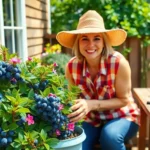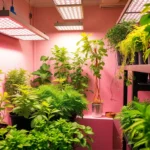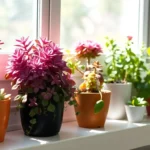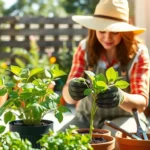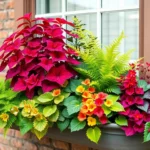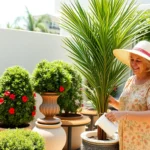Glass containers transform ordinary houseplants into stunning living art pieces that captivate every visitor. We’ve discovered that these transparent vessels create miniature ecosystems while showcasing your plants’ natural beauty from every angle. Whether you’re working with succulents, air plants, or tropical varieties, glass containers offer endless possibilities for creative displays.
The magic happens when we combine plants with glass – suddenly your green friends become conversation starters and focal points throughout your home. These versatile containers work perfectly on windowsills, desks, shelves, or as centerpieces. Plus, they’re incredibly low-maintenance once you understand the basics.
We’ll show you exactly how to choose the right plants, prepare your containers, and create thriving glass gardens that last for months. From selecting proper drainage materials to understanding watering techniques, you’ll master the art of glass container gardening and transform your space into a botanical showcase.
Choose the Right Glass Container for Your Plants
Selecting the perfect glass container sets the foundation for your thriving indoor garden. We’ll explore the key factors that determine whether your plants flourish or struggle in their transparent homes.
Clear Glass Versus Colored Glass Options
Clear glass containers offer the best visibility for monitoring plant health and root development. We can easily spot issues like overwatering, pest problems, or nutrient deficiencies through transparent walls. Clear vessels also allow maximum light penetration, supporting photosynthesis for all plant types including succulents, ferns, and flowering varieties.
Colored glass options provide unique aesthetic appeal but come with exact considerations. Green and blue tinted containers filter certain light wavelengths, which can slow growth rates for light-hungry plants like air plants and cacti. Amber or brown glass protects sensitive root systems from direct sunlight exposure, making these containers ideal for delicate plants such as baby tears or small orchids.
Frosted glass containers strike a balance between style and function. We recommend these for plants that prefer indirect lighting conditions, as the frosted surface diffuses harsh rays while maintaining adequate brightness for healthy growth.
Size and Shape Considerations
Container diameter should accommodate your plant’s mature size with 1-2 inches of growing space on all sides. Small succulents thrive in 4-6 inch diameter vessels, while larger plants like snake plant cuttings need 8-10 inch containers for proper root expansion.
Height requirements vary significantly based on plant type and root structure. Shallow containers (2-3 inches deep) work perfectly for air plants and small succulents with minimal root systems. Deep vessels (6-8 inches) accommodate plants with extensive root networks like pothos cuttings or small ferns.
Opening width affects maintenance accessibility and plant health. Wide-mouth containers allow easy watering, pruning, and cleaning, while narrow openings create greenhouse effects that benefit humidity-loving plants like moss and small tropical varieties.
| Container Type | Ideal Diameter | Best Height | Suitable Plants |
|---|---|---|---|
| Terrarium Bowl | 6-12 inches | 4-6 inches | Succulents, Air Plants |
| Tall Cylinder | 4-8 inches | 8-12 inches | Snake Plants, Pothos |
| Wide Sphere | 8-14 inches | 6-10 inches | Fern Gardens, Moss |
| Narrow Vase | 3-5 inches | 10-16 inches | Single Stem Plants |
Drainage Requirements for Different Container Types
Containers without drainage holes require careful water management and specialized layering techniques. We create drainage systems using activated charcoal, pebbles, and sphagnum moss to prevent root rot in closed terrariums. These setups work best for drought-tolerant plants like echeveria, jade plants, and air plants that prefer drier conditions.
Self-draining containers feature built-in drainage systems or removable bottom sections. We prefer these for plants requiring consistent moisture like ferns, baby tears, and tropical varieties. The excess water collection prevents root damage while maintaining proper humidity levels.
Open-top containers allow natural evaporation and air circulation, making them suitable for a wider range of plants. We use these for herb gardens, succulent arrangements, and plants that benefit from occasional drying periods between waterings.
Double-wall systems provide the best of both worlds with an inner planting container and outer decorative vessel. We can easily remove plants for thorough watering and maintenance while preserving the aesthetic appeal of seamless glass displays.
Select the Best Plants for Glass Container Gardens

Now that we’ve covered container selection, let’s explore the plant varieties that’ll transform your glass vessels into stunning living displays.
Low-Maintenance Succulents and Cacti
Succulents represent our most recommended choice for open glass containers due to their exceptional drought tolerance and compact growth habits. These hardy plants thrive with minimal soil requirements and bright, indirect light conditions. Echeveria varieties showcase beautiful rosette formations that create striking visual focal points in clear glass vessels.
Small cacti species work particularly well in glass jars without drainage systems since they naturally store water in their tissues. We must emphasize careful watering practices with these plants, as excess moisture can quickly lead to root rot in glass containers with poor drainage. Watering succulents and cacti sparingly every 2-3 weeks typically provides adequate moisture for healthy growth.
Many succulent varieties like jade plants, string of pearls, and hens and chicks maintain compact sizes perfect for glass container dimensions. Their diverse textures, colors, and growth patterns offer endless design possibilities for your glass garden arrangements.
Humidity-Loving Tropical Plants
Closed glass terrariums create ideal microclimates for moisture loving tropical species that struggle in typical household environments. These plants flourish in the consistent humidity levels that sealed glass containers naturally maintain. Ferns like maidenhair and Boston varieties thrive in the moist atmosphere while adding lush, delicate foliage textures.
Mini palms, peperomias, and carnivorous plants like Venus flytraps excel in these humid conditions with low to moderate indirect light requirements. Spider plants adapt remarkably well to terrarium environments, producing cascading foliage that creates natural living sculptures within glass boundaries.
Orchids represent premium choices for larger closed containers, though they require more specialized care and attention to airflow patterns. Mosses serve as excellent companion plants, creating carpet like groundcover that enhances the miniature network aesthetic while helping maintain consistent moisture levels.
Air Plants That Thrive Without Soil
Air plants offer revolutionary simplicity for glass container gardening since they eliminate soil requirements entirely. These Tillandsia species absorb moisture and nutrients directly through their specialized leaf structures, making them perfect for minimalist glass displays. We can mount them on decorative substrates like driftwood, stones, or coral pieces within open glass bowls.
Their maintenance involves simple weekly misting or monthly soaking sessions, making them ideal for busy plant enthusiasts. Air plants complement modern home decor with their architectural forms and silvery green coloration that contrasts beautifully against clear glass surfaces.
These plants work exceptionally well in hanging glass globes, geometric terrariums, or wide mouth mason jars where their unique forms become living art pieces. Their ability to survive solely on air moisture makes them practically foolproof choices for beginners starting their glass container garden journey.
Prepare Your Glass Container for Planting

Setting up your glass container properly creates the foundation for a thriving miniature network. We’ll walk you through the essential preparation steps that ensure your plants flourish in their new glass home.
Clean and Sterilize Your Container
Thorough cleaning removes dirt, residues, and harmful pathogens that could compromise your plants’ health. Start by washing your glass container with warm soapy water to eliminate any surface contaminants. Rinse the container completely to remove soap residue that might affect plant growth.
Sterilization prevents mold and bacterial growth in the closed glass environment. Apply a diluted bleach solution or hydrogen peroxide to all interior surfaces. Allow the sterilizing agent to sit for several minutes before rinsing thoroughly with clean water. Let your container dry completely before proceeding to the next step.
Create Proper Drainage Layers
Drainage layers prevent waterlogging and root rot since glass containers typically lack drainage holes. Begin by adding a layer of small pebbles or coarse gravel to the bottom of your container. This foundation layer should be approximately 1-2 inches deep depending on your container size.
Proper drainage allows excess water to settle away from roots and creates a healthy growing environment. The pebbles create air pockets that help water movement and prevent stagnant conditions. Choose materials like river rocks, aquarium gravel, or decorative stones that won’t decompose over time.
Add Activated Charcoal for Filtration
Activated charcoal filters water and absorbs impurities that could harm your plants in the enclosed environment. Sprinkle a thin layer of activated charcoal directly over your drainage layer. Use approximately 1/4 to 1/2 inch of charcoal depending on your container size.
Charcoal prevents decay, mold, and foul odors by regulating moisture and maintaining air quality inside your glass container. The filtration properties help create a balanced network that supports healthy plant growth. Purchase horticultural activated charcoal rather than barbecue charcoal for best results.
Plant Your Glass Container Garden Step by Step
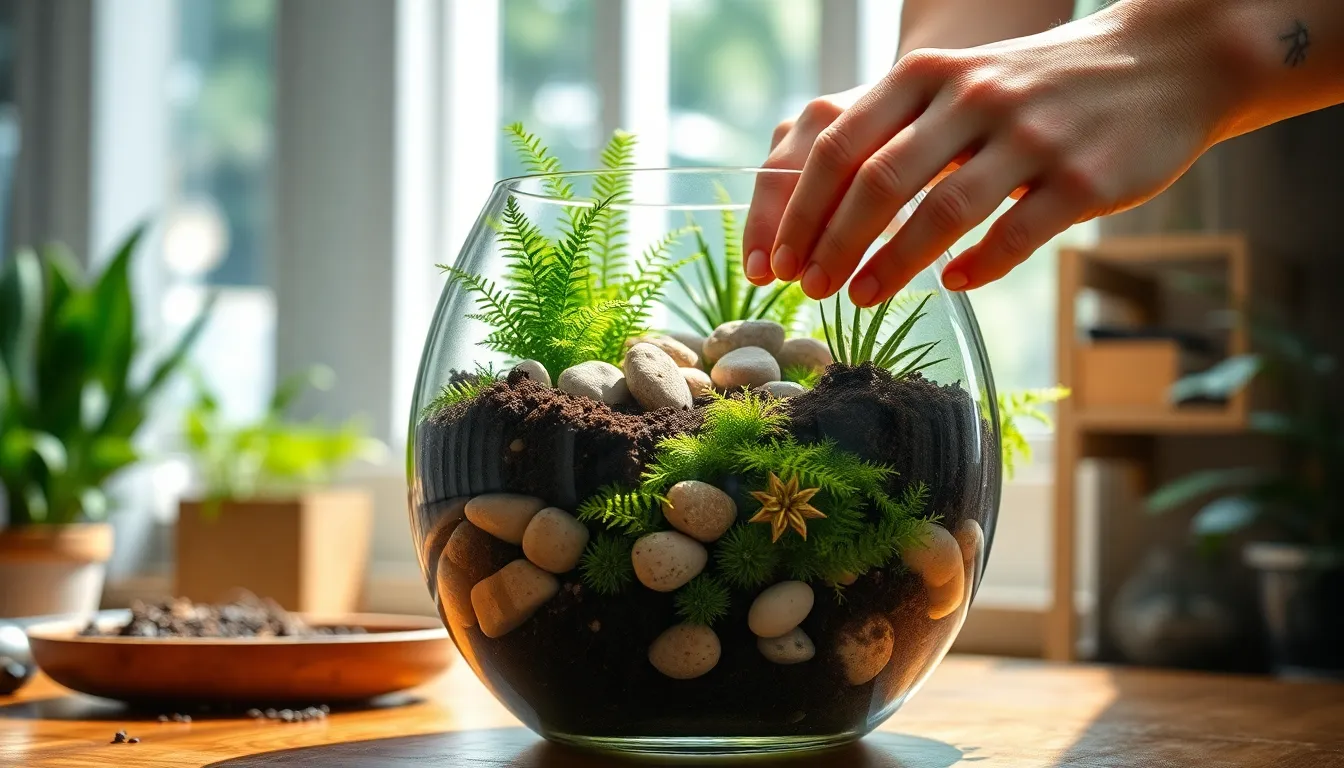
Now that we’ve prepared our container, let’s build our miniature network layer by layer. We’ll create a foundation that supports healthy plant growth while maintaining the perfect balance of drainage and nutrition.
Layer Your Growing Medium Correctly
Creating the drainage foundation comes first by placing small pebbles or gravel at the bottom of our container. This prevents waterlogging and ensures excess moisture can escape from plant roots. We need about one to two inches of drainage material depending on our container size.
Adding activated charcoal as our second layer helps absorb odors and keeps the soil fresh throughout the growing season. We’ll spread a thin layer directly over our drainage materials to create an effective filtration system.
Placing sphagnum moss creates an optional barrier that prevents our potting soil from mixing with the charcoal below. This natural separator maintains distinct layers while allowing proper water movement through our growing medium.
Filling with potting soil completes our foundation using sterile, houseplant formulated growing medium. We avoid old garden soil to prevent disease and fungal issues that could harm our enclosed network. The soil layer should be deep enough to accommodate our plants’ root systems comfortably.
Arrange Plants for Visual Appeal
Grouping plants with similar needs ensures our container garden thrives by placing species with matching light and water requirements together. We create harmonious growing conditions that make maintenance easier and more effective.
Using different heights and textures adds visual interest by combining tall, medium, and low growing plants throughout our display. Small tropical plants, ferns, and mosses work exceptionally well in closed terrariums where humidity levels remain consistent.
Selecting appropriate species for our container type maximizes success rates since succulents suit open terrariums with more light exposure and less humidity. We create small depressions in the soil for each plant and gently separate roots to encourage healthy spreading.
Positioning strategically involves placing taller plants toward the back and shorter ones in front to create depth and dimension. We press soil lightly around each plant’s base to secure placement without compacting the growing medium.
Add Decorative Elements and Finishing Touches
Incorporating decorative stones enhances our visual composition by adding texture and color contrast throughout the planted areas. We can include moss, small figurines, or colored gravel to create focal points that complement our plant selections.
Avoiding flowering plants prevents maintenance issues since decaying flowers can cause fungal problems in enclosed environments. We focus on foliage plants that maintain consistent appearance without requiring frequent flower removal.
Watering carefully after planting ensures proper soil moisture without creating waterlogged conditions that harm plant roots. We apply water lightly since terrariums recycle moisture internally and require less frequent watering than traditional potted plants.
Adding final touches includes positioning any remaining decorative elements and checking that all plants have adequate space for growth. We ensure our finished container garden has balanced composition with proper spacing between all elements.
Care for Plants in Glass Containers Daily
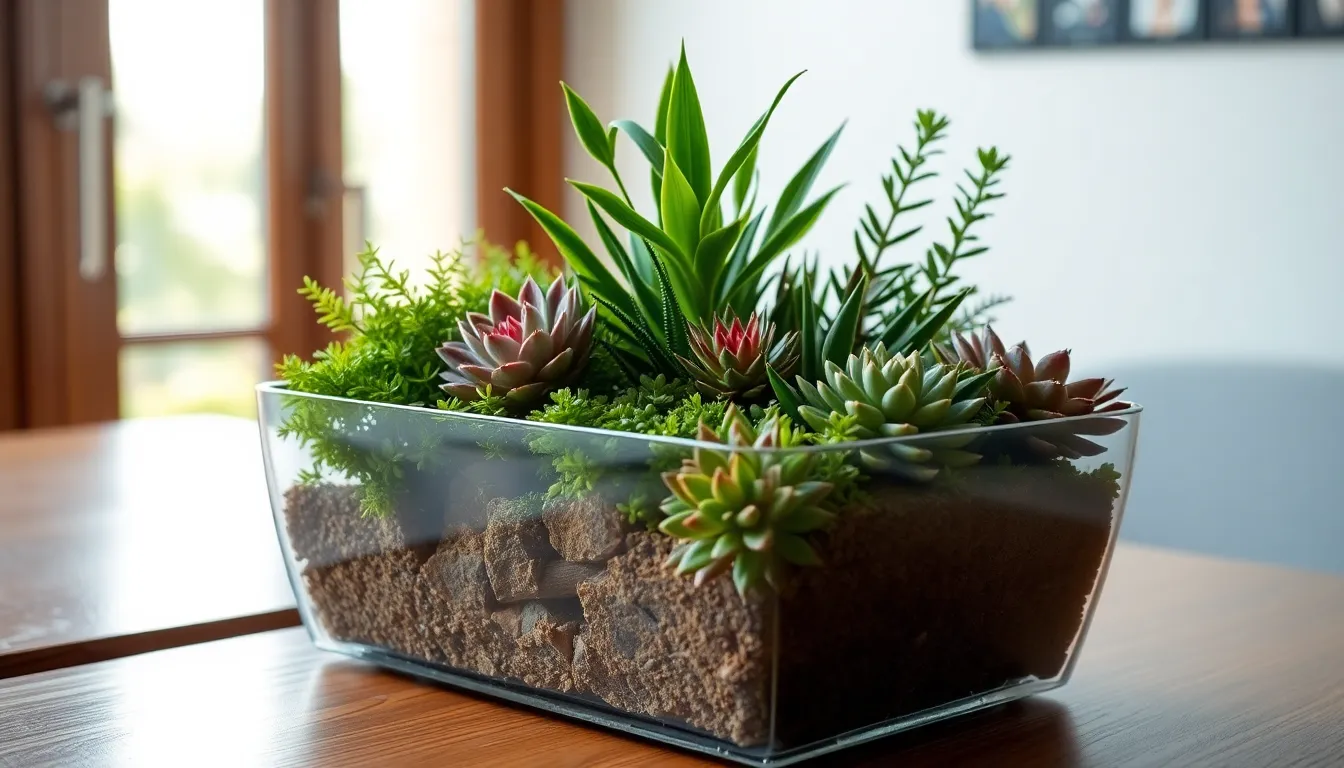
Once you’ve established your glass container garden, maintaining it properly ensures your miniature network thrives year-round. Daily care routines focus on three critical areas that directly impact plant health and longevity.
Water Management and Humidity Control
Watering frequency varies dramatically between container types. Closed terrariums recycle moisture naturally and typically need watering only every few months, while open containers require weekly attention or whenever soil feels dry to the touch.
Overwatering poses the greatest threat to glass container plants. Excess moisture creates waterlogged conditions that kill roots and encourage harmful bacteria growth. We recommend watering lightly to maintain consistent moisture without creating saturation.
Charcoal layers provide essential environmental benefits. Adding activated charcoal to your soil mixture helps keep the enclosed environment fresh and actively prevents mold formation by combating overwatering effects.
Humidity management differs between open and closed systems. Closed terrariums create self-sustaining humidity levels that rarely need adjustment, but open containers require more frequent moisture monitoring to prevent plant stress.
Light Requirements and Placement
Closed terrariums thrive in bright, indirect light conditions. Position these containers approximately 1 meter from north-facing windows or further distances from east, west, or south-facing windows to prevent overheating and leaf burn.
Open terrariums prefer full or partial sun exposure. These containers work ideally for succulents and plants requiring higher light levels. Move containers to brighter locations if plants become leggy or fail to produce flowers.
Direct sunlight damages both container types and surrounding areas. Glass magnifies heat intensity and can scorch plant foliage or nearby surfaces, making filtered light the safest option for all glass container gardens.
Pruning and Maintenance Tips
Regular pruning maintains both plant health and visual appeal. Trim dead or yellowing leaves and stems promptly to prevent decay from spreading throughout your enclosed network.
Decaying material removal prevents serious fungal diseases. Remove any dying foliage immediately to stop botrytis and other harmful pathogens from establishing in your container’s humid environment.
Fertilizing requires careful restraint in glass containers. Apply controlled-release fertilizer only once yearly, as nutrient buildup in confined spaces can harm plants more than benefit them.
Soil quality impacts long-term success significantly. Use sterile, formulated growing media instead of garden soil to avoid introducing harmful pathogens into your controlled environment.
Troubleshoot Common Glass Container Garden Problems
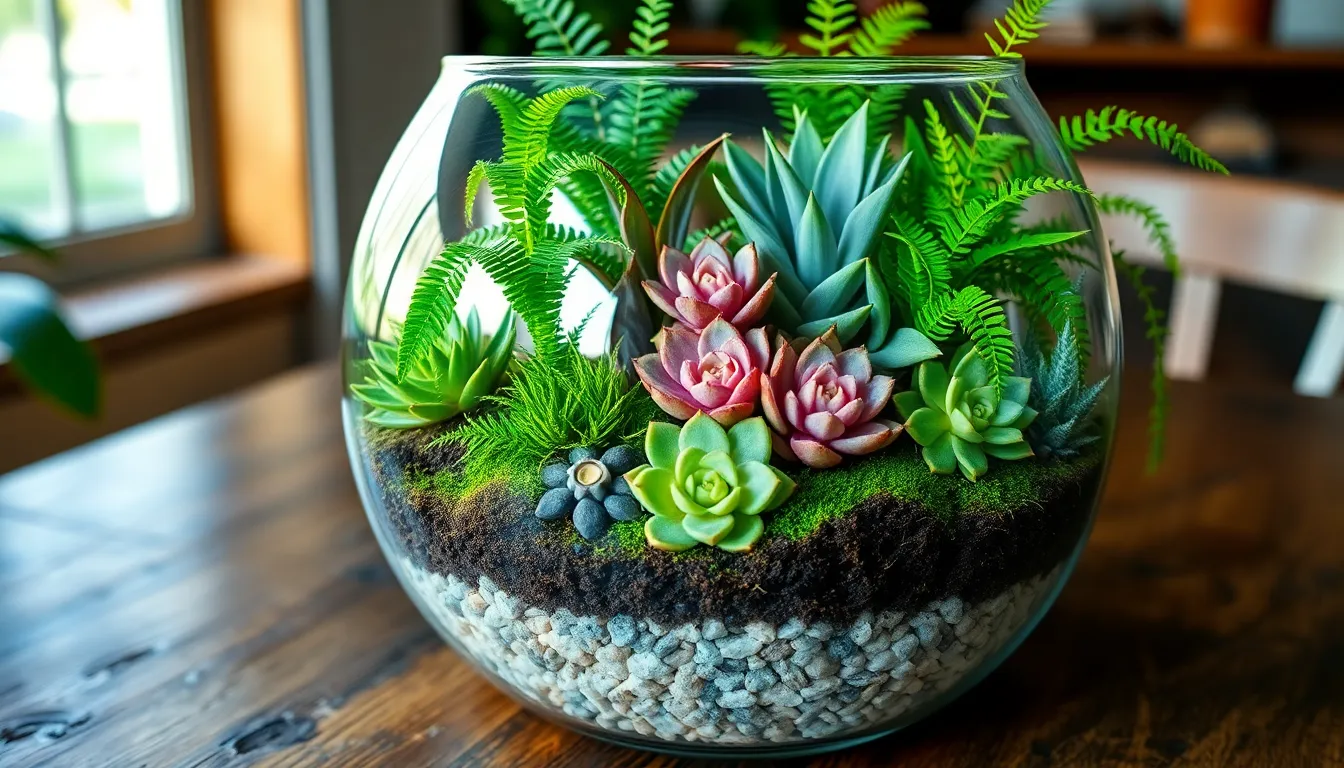
Even with proper care, glass container gardens can face exact challenges that require targeted answers. We’ll address the most common issues and provide practical fixes to keep your miniature ecosystems thriving.
Prevent and Treat Fungal Issues
Activated charcoal becomes your first line of defense against fungal growth in glass containers. Adding this natural filter to your soil mix absorbs excess moisture and toxins that fuel fungal development. We recommend incorporating a thin layer between your drainage material and growing medium.
Removing decaying plant matter immediately prevents fungal diseases like botrytis from spreading throughout your container. Dead leaves, wilted stems, and faded flowers create perfect breeding grounds for harmful spores. Check your plants weekly and prune away any deteriorating material with clean, sterilized scissors.
Maintaining proper airflow reduces the high humidity levels that encourage fungal growth. Open your closed terrariums periodically to refresh the air, or remove the lid entirely for a few hours when condensation builds up excessively on the glass walls.
Cleaning your container thoroughly before planting eliminates fungal spores and bacteria that could establish themselves in your network. Use a diluted bleach solution followed by thorough rinsing to sterilize both the glass and any decorative accessories.
Manage Overwatering and Root Rot
Watering sparingly protects your plants from the most common glass container problem. Closed systems recycle moisture naturally and typically need water only every few months, while open containers may require weekly attention when the soil feels dry to the touch.
Creating well-draining substrate layers prevents standing water that leads to root rot. Place gravel or coarse sand at the bottom of your container to allow excess water to drain away from plant roots. This drainage layer should comprise roughly 20% of your container’s total depth.
Monitoring soil moisture levels helps you avoid the waterlogged conditions that kill most terrarium plants. The growing medium should feel slightly moist but never soggy or saturated. If you notice standing water in your drainage layer, reduce watering frequency immediately.
Using sterile, formulated growing mediums prevents introducing pathogens that thrive in overly wet conditions. Avoid old garden soil or previously used potting mix, which can harbor harmful microorganisms that cause root rot in enclosed environments.
Address Pest Control in Enclosed Environments
Inspecting plants thoroughly before planting prevents introducing pests into your sealed network. Examine leaves, stems, and soil for signs of insects, spider mites, or other unwanted visitors that could multiply rapidly in the confined space.
Keeping the environment clean reduces pest attraction and breeding opportunities. Remove any fallen leaves, dead plant material, or organic debris that insects might use for shelter or food sources.
Spot treating pests carefully requires gentle methods suitable for enclosed spaces. Use insecticidal soap or neem oil sparingly, as chemical treatments can become concentrated and harmful in glass containers with limited ventilation.
Rotating your terrarium occasionally ensures even light exposure and prevents the stagnant conditions that some pests prefer. This simple practice also helps you spot pest problems early when they’re easier to manage.
Style Your Glass Container Gardens for Home Decor
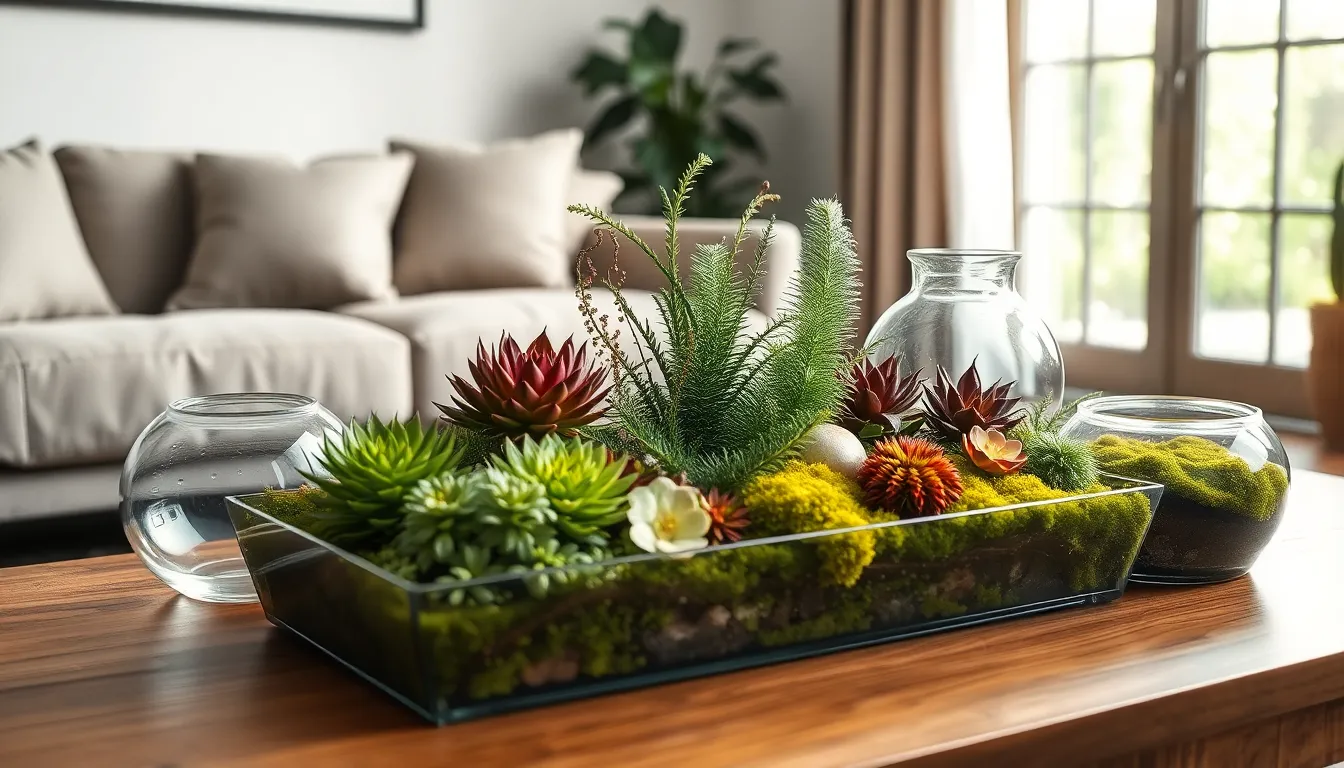
Glass containers transform ordinary plants into stunning decorative elements that enhance your living space. We’ll explore creative ways to style these gardens as focal points throughout your home.
Create Themed Terrarium Displays
Themed terrariums become conversation pieces that reflect your personal style and seasonal preferences. Victorian greenhouse themes work beautifully with ornate glass containers and delicate ferns, creating an elegant vintage atmosphere. Beach or desert landscapes feature succulents paired with decorative sand and small shells, bringing coastal vibes indoors.
Whimsical fairy gardens incorporate tiny decorations like miniature furniture, bridges, and figurines alongside moss and small plants. Small glass lockets or perfume bottles serve as unique terrarium displays perfect for rare or delicate specimens. Recycled vintage glass adds character while supporting sustainable decorating practices.
Seasonal themes keep your displays fresh throughout the year. Winter terrariums might feature white stones and silver accents, while autumn displays can include warm colored leaves and small pumpkin decorations. Holiday themed containers become beautiful centerpieces that complement your existing decor.
Group Multiple Containers for Impact
Multiple glass containers create dramatic visual impact when arranged thoughtfully together. Varying sizes and shapes add depth and interest to your displays, from tall cylinder vases to wide shallow bowls. Mix plant textures by combining spiky succulents with trailing pothos or soft mosses for ever-changing contrast.
Coordinate containers by choosing similar glass colors or deliberately contrasting styles for bold statements. Clear glass bowls paired with tinted vintage jars create sophisticated layered arrangements. Place groupings on floating shelves, console tables, or bright windowsills where they catch natural light.
Three to five containers work best for most spaces without overwhelming the area. Arrange them at different heights using books, plant stands, or wall mounted shelves to create visual flow. This approach works particularly well in apartments or small homes where outdoor gardening space is limited.
Incorporate Glass Gardens into Different Room Designs
Living rooms benefit from glass container gardens placed on coffee tables or side tables where they add fresh organic elements to modern or eclectic decor. Office spaces feel more inviting with small terrarium displays on desks or bookcases, improving air quality while reducing stress.
Kitchen windowsills accommodate herb gardens in mason jars or clear containers, providing fresh ingredients while adding green accents. Bathroom environments suit closed terrariums filled with humidity loving plants like small ferns or tropical varieties that thrive in steamy conditions.
Bedrooms welcome small glass gardens on nightstands or dressers, creating calming atmospheres that promote restful sleep. Their transparent nature complements light and airy interior designs while working well in spots with indirect sunlight. Plant selection and maintenance requirements depend on each room’s exact light conditions and airflow patterns.
Glass container gardens adapt seamlessly to any decorating style, from minimalist modern to cozy farmhouse aesthetics. Their versatility makes them ideal accent pieces that bring nature indoors without requiring major design changes.
Conclusion
Glass container gardens offer us an incredible opportunity to bring nature indoors while creating stunning visual displays. We’ve covered everything from selecting the perfect containers and plants to mastering daily care routines and troubleshooting common issues.
The beauty of these miniature ecosystems lies in their versatility and low-maintenance nature. Whether we’re creating a simple succulent arrangement or an elaborate tropical terrarium our glass gardens can transform any space into a green sanctuary.
With proper preparation drainage layers and the right plant choices we can enjoy thriving glass gardens that serve as living art pieces in our homes. These captivating displays prove that gardening doesn’t require vast outdoor spaces – sometimes the most beautiful gardens come in the smallest packages.
Frequently Asked Questions
What are the best plants for glass container gardens?
Succulents and cacti work best for open glass containers due to their drought tolerance and compact growth. Popular choices include Echeveria and jade plants. For closed terrariums, humidity-loving tropical plants like ferns, mini palms, and orchids thrive in the moist environment. Air plants are ideal for minimalist displays since they require no soil.
How often should I water plants in glass containers?
Watering frequency depends on container type. Closed terrariums need minimal watering due to their self-sustaining humidity cycle. Open containers typically require weekly watering. Always check soil moisture before watering and avoid overwatering, which can lead to root rot and bacterial growth.
What type of glass container should I choose for my plants?
Clear glass containers are recommended for optimal light penetration and plant visibility. Consider the mature size of your plants when selecting container dimensions. Ensure proper drainage for open containers, while closed containers should maintain appropriate humidity levels for the chosen plant species.
How do I prepare a glass container for planting?
Start by cleaning and sterilizing the container to prevent contamination. Create a drainage layer using pebbles or gravel, then add activated charcoal for filtration. Layer appropriate potting soil on top. This preparation ensures proper water management and air quality for healthy plant growth.
What lighting conditions do glass container gardens need?
Closed terrariums thrive in bright, indirect light to prevent overheating and maintain humidity balance. Open containers prefer full or partial sun depending on plant requirements. Avoid direct harsh sunlight that can cause leaf burn and excessive temperature fluctuations in glass environments.
How do I prevent fungal growth in my glass garden?
Use activated charcoal in your container setup to combat fungal issues. Remove any decaying plant matter immediately and ensure proper airflow. Maintain appropriate moisture levels without overwatering, and use sterile growing media to prevent introducing harmful pathogens into your miniature ecosystem.
Can I create themed displays with glass container gardens?
Yes, glass containers offer excellent opportunities for creative themed displays. You can create Victorian greenhouse themes, beach landscapes, fairy gardens, or seasonal displays. Group multiple containers of varying sizes and shapes for visual impact and incorporate decorative elements that complement your chosen theme.
What common problems should I watch for in glass gardens?
Monitor for overwatering signs like root rot, fungal growth, and pest infestations. Remove dead or decaying plant material promptly. Ensure proper drainage and airflow to prevent moisture-related issues. Inspect plants before planting and maintain appropriate light conditions to avoid leaf burn or stunted growth.


